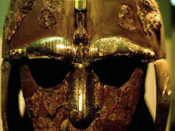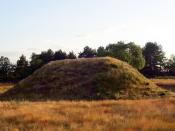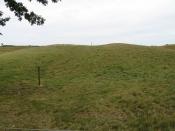What can the study of grave-goods tell us about the nature of society?
The Anglo-Saxon ship, Sutton Hoo, was discovered by Basil Brown in 1939 in a burial mound near Woodbridge, Suffolk, in southeast England, and was excavated in 1939 and in 1965-7. This excavation provided a number of aspects of the study of Anglo-Saxons. It shows aspects of the Christian conversion, everyday life, religion, customs, kingdoms, myths and legends, and the study of the remains of the Anglo-Saxons - their artefacts and buildings. Sutton Hoo provides virtually the only evidence for the development of kingship during this period, and is the key source for the moment when the Anglo-Saxons ceased to be tribal and began to form kingdoms.
Sutton Hoo is a burial ground dating from the early 7th century AD, and was probably the main burial ground of the pagan Kings of East Anglia. Therefore the grave goods may not quite be representative of the 'ordinary' person and the 'everyday' objects of Anglo-Saxon households.
However, they give us an idea of the type of possessions the more elitist (wealthy, powerful, royal) had and the importance of ceremonies, entertainment and feasting. There is considerable evidence from the Sutton Hoo material that the people buried in the cemetery had strong connections with Scandinavia. "Certainly the custom of ship burials is a Nordic one - there are many similar Viking remains in Denmark and Sweden" . Many objects were either imported, traded or copied. In particular the shield and helmet are very similar to examples found in the Vendel region of Southern Sweden. Decorative designs found on the helmet and other objects are also paralleled by Swedish examples. The family group represented at Sutton Hoo is assumed to be the Wuffings, who had strong Scandinavian links and claimed descent from...


